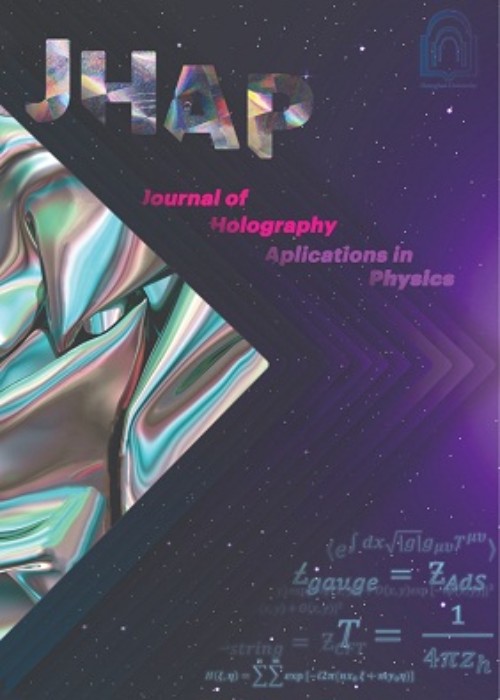فهرست مطالب

Journal of Holography Applications in Physics
Volume:3 Issue: 4, Autumn 2023
- تاریخ انتشار: 1402/08/10
- تعداد عناوین: 6
-
-
Pages 1-4
This letter presents a mathematical model that may help address the long-standing problem of galaxy rotation curves. The strategy involves exploring the variation of circular velocity `ν' with respect to radial distance `r' as a result of which a Bessel differential equation is developed, yielding a general functional form of the potential as a Bessel function. Employing this potential in the case of galaxies, we find the velocity profile in terms of Bessel functions. This approach establishes Bessel functions as a powerful choice for investigating galactic rotation and deepening our understanding of the universe.
Keywords: Galactic Rotation Curves, Flatness Problem, Functional Form -
Pages 5-22
We review recent developments concerning the soft factorization of scattering amplitudes that arise in the large radius limit of four dimensional Anti-de Sitter (AdS$_4$) spacetimes. This includes the presence of AdS radius dependent corrections of known flat spacetime soft factors and their implication on the relationship between soft theorems and Ward identities of the boundary conformal field theory.
Keywords: AdS-CFT correspondence, Soft theorems, Asymptotic symmetries -
Large Field and Small Field Inflation Models in Confrontation with Planck2018 and BICEP2018 DatasetsPages 23-38
We study the non-minimal inflation with both the large field and small field potentials in the context of the new observational data. We analyze the linear and non-linear perturbations to obtain the scalar spectral index, tensor-to-scalar ratio, and nonlinearity parameter. By performing a numerical analysis on the scalar spectral index and tensor-to-scalar ratio, and comparing the results with Planck2018 TT, TE, EE+lowE+lensing+BAO+BK14(18) data, we find that the non-minimal large field inflation is observationally viable if the non-minimal coupling parameter is of the order of $10^{-3}$. The same analysis on the non-minimal small field inflation gives the values for the non-minimal coupling parameter as $10^{-4}$. We also study the non-Gaussian features in both equilateral and orthogonal configurations for large and small field potentials and find small values for these amplitudes, consistent with Planck2018 TTT, EEE, TTE and EET data. We show that the absolute values of the non-linearity parameter, $f_{NL}$, is larger in large field inflation than the small field model for both configurations. Also, we obtain more severe constraints on the parameter $p$ in the introduced large field and small field potentials with respect to previously reported constraints.
Keywords: Non-Minimal Inflation, Large Field Inflation, Small Field Inflation, Non-Gaussianity, Observational Constraints -
Pages 39-56
We propose a generalisation of the Moore-Tachikawa varieties for the case in which the target category of the 2D TFT is a hyperkaehler quotient. The setup requires generalising the bordism operators of Moore and Segal to the case involving lack of reparametrisation-invariance on the Riemann surface, ultimately enabling to relate this to the issue of defining a Drinfeld center for composite class S theories.
Keywords: cochain level theories, symplectic varieties, topological field theories, categorical duality, quiver gauge theories, higher categories, relative QFTs -
Pages 57-80
In this paper we review the novel connection between a theory of N M2-branes on (C^2/Z_2 x C/Z_2)/Z_k and a discrete integrable system. Besides the IR duality induced by the Hanany-Witten transitions in the type IIB brane construction, the Fermi gas formalism tells us that the partition function of this theory enjoys a larger discrete symmetry which is the Weyl group W(D_5) of D_5=SO(10). The Fermi gas formalism, together with the topological string/spectral theory correspondence and the connection between the integrable systems and the Nekrasov partition functions recently found, further suggests that the grand partition function of this M2-brane partition function satisfies a bilinear difference equation associated with W(D_5), called q-deformed Painleve VI. By using the exact values of the partition functions we identify the explicit expression of the bilinear equations and confirm that these equations are indeed satisfied for higher order in the chemical potential dual to the rank N. This article is based on [Bonelli, Globlek, Kubo, Nosaka, Tanzini, Lett. Math. Phys. 112 no. 6, (2022) 109] and [Moriyama, JHEP 08 (2023) 191].
Keywords: M2-branes, M-theory, dualities, matrix model, Painleve equation -
Pages 81-87
It is a sort of ultimate question to examine the continuity of a quantum measurement subject theoretically and has not yet been resolved within a scientific framework.In this article, we approach this question and argue that the continuity of a quantum measurement subject follows as a fundamental consequence of the holographic principle after the classicalization of the quantum state of the bulk space.
Keywords: Quantum Measurement, von Neumann Entropy, Holographic Principle, Wick Rotation

